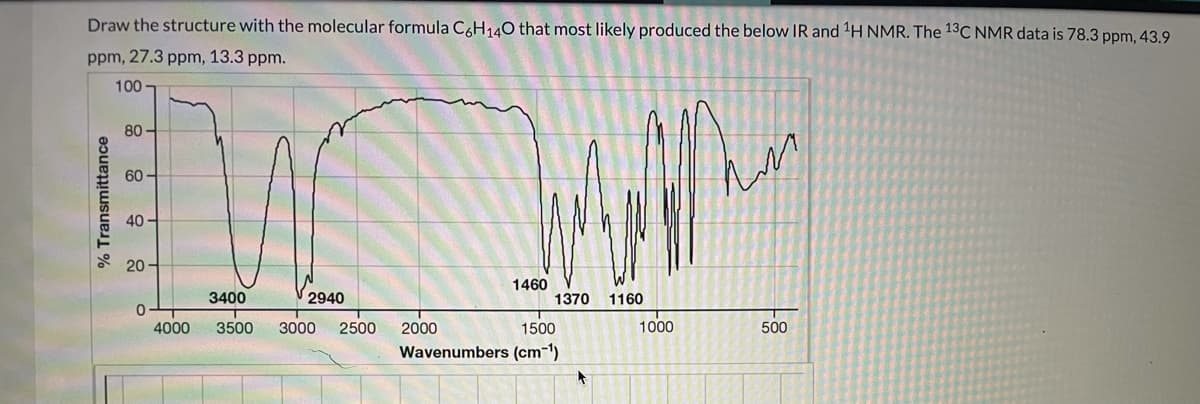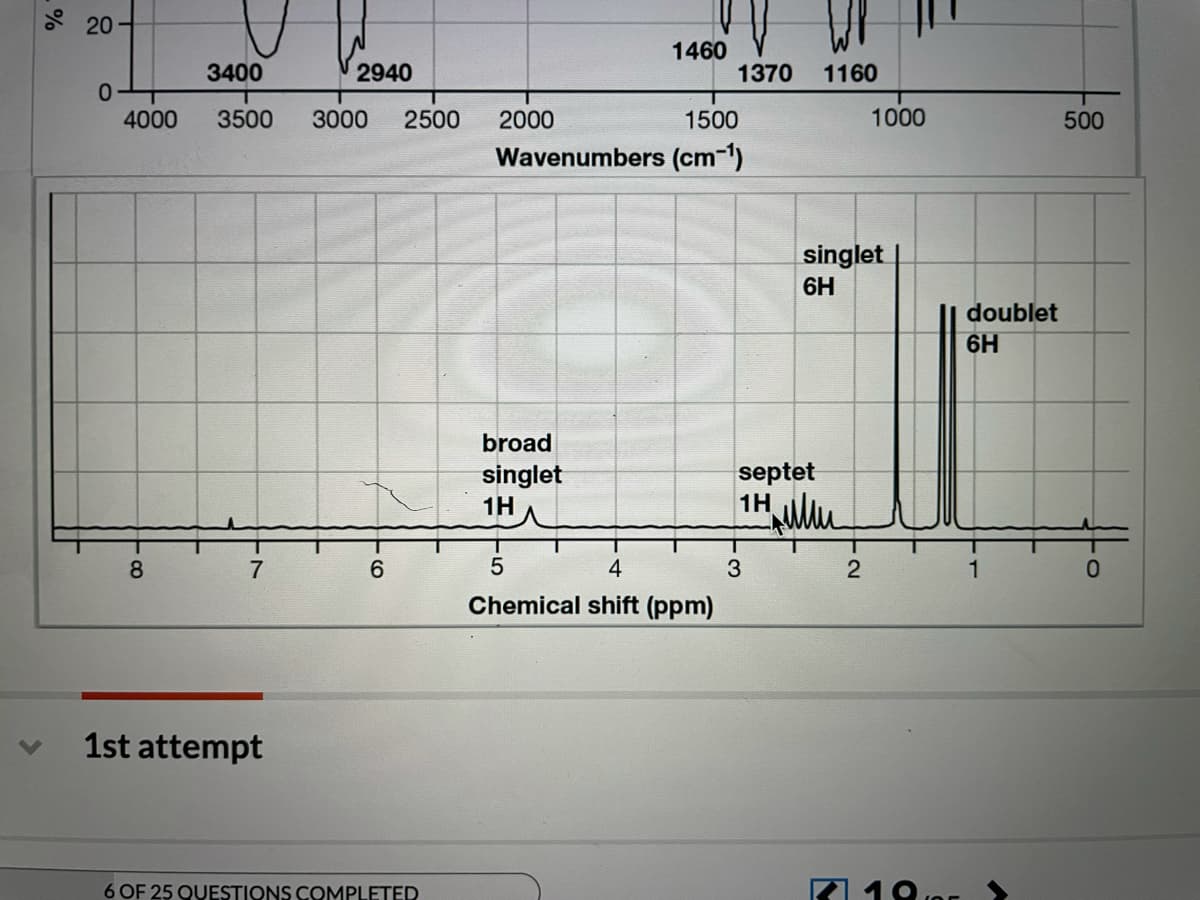Draw the structure with the molecular formula CgH140 that most likely produced the below IR and H NMR. The 13C NMR data is 78.3 ppm, 43.9 ppm, 27.3 ppm, 13.3 ppm. 100 80- 60 - 40- 20 1460 3400 2940 1370 1160 4000 3500 3000 2500 2000 1500 1000 500 Wavenumbers (cm-1)
Draw the structure with the molecular formula CgH140 that most likely produced the below IR and H NMR. The 13C NMR data is 78.3 ppm, 43.9 ppm, 27.3 ppm, 13.3 ppm. 100 80- 60 - 40- 20 1460 3400 2940 1370 1160 4000 3500 3000 2500 2000 1500 1000 500 Wavenumbers (cm-1)
Chemistry
10th Edition
ISBN:9781305957404
Author:Steven S. Zumdahl, Susan A. Zumdahl, Donald J. DeCoste
Publisher:Steven S. Zumdahl, Susan A. Zumdahl, Donald J. DeCoste
Chapter1: Chemical Foundations
Section: Chapter Questions
Problem 1RQ: Define and explain the differences between the following terms. a. law and theory b. theory and...
Related questions
Question

Transcribed Image Text:Draw the structure with the molecular formula CgH140 that most likely produced the below IR and H NMR. The 13C NMR data is 78.3 ppm, 43.9
ppm, 27.3 ppm, 13.3 ppm.
100
80-
60 -
40-
20
1460
3400
2940
1370
1160
4000
3500
3000
2500
2000
1500
1000
500
Wavenumbers (cm-1)

Transcribed Image Text:8 20
1460
3400
2940
1370
1160
4000
3500
3000
2500
2000
1500
1000
500
Wavenumbers (cm-1)
singlet
6H
doublet
6H
broad
septet
1H
singlet
1H
8
6.
4
2
Chemical shift (ppm)
1st attempt
6 OF 25 QUESTIONS COMPLETED
の10
Expert Solution
Step 1
Identification of organic compound can be done by spectroscopic techniques.
The techniques are : IR, 1H-NMR and 13C-NMR.
Chemical shift value of a proton/C depends on the electronic environment. Greater is the electron deficiency, higher will be the chemical shift value.
Splitting of a proton is based on the (n+1) rule where n is the no of chemically non-equivalent protons.
Trending now
This is a popular solution!
Step by step
Solved in 2 steps

Knowledge Booster
Learn more about
Need a deep-dive on the concept behind this application? Look no further. Learn more about this topic, chemistry and related others by exploring similar questions and additional content below.Recommended textbooks for you

Chemistry
Chemistry
ISBN:
9781305957404
Author:
Steven S. Zumdahl, Susan A. Zumdahl, Donald J. DeCoste
Publisher:
Cengage Learning

Chemistry
Chemistry
ISBN:
9781259911156
Author:
Raymond Chang Dr., Jason Overby Professor
Publisher:
McGraw-Hill Education

Principles of Instrumental Analysis
Chemistry
ISBN:
9781305577213
Author:
Douglas A. Skoog, F. James Holler, Stanley R. Crouch
Publisher:
Cengage Learning

Chemistry
Chemistry
ISBN:
9781305957404
Author:
Steven S. Zumdahl, Susan A. Zumdahl, Donald J. DeCoste
Publisher:
Cengage Learning

Chemistry
Chemistry
ISBN:
9781259911156
Author:
Raymond Chang Dr., Jason Overby Professor
Publisher:
McGraw-Hill Education

Principles of Instrumental Analysis
Chemistry
ISBN:
9781305577213
Author:
Douglas A. Skoog, F. James Holler, Stanley R. Crouch
Publisher:
Cengage Learning

Organic Chemistry
Chemistry
ISBN:
9780078021558
Author:
Janice Gorzynski Smith Dr.
Publisher:
McGraw-Hill Education

Chemistry: Principles and Reactions
Chemistry
ISBN:
9781305079373
Author:
William L. Masterton, Cecile N. Hurley
Publisher:
Cengage Learning

Elementary Principles of Chemical Processes, Bind…
Chemistry
ISBN:
9781118431221
Author:
Richard M. Felder, Ronald W. Rousseau, Lisa G. Bullard
Publisher:
WILEY